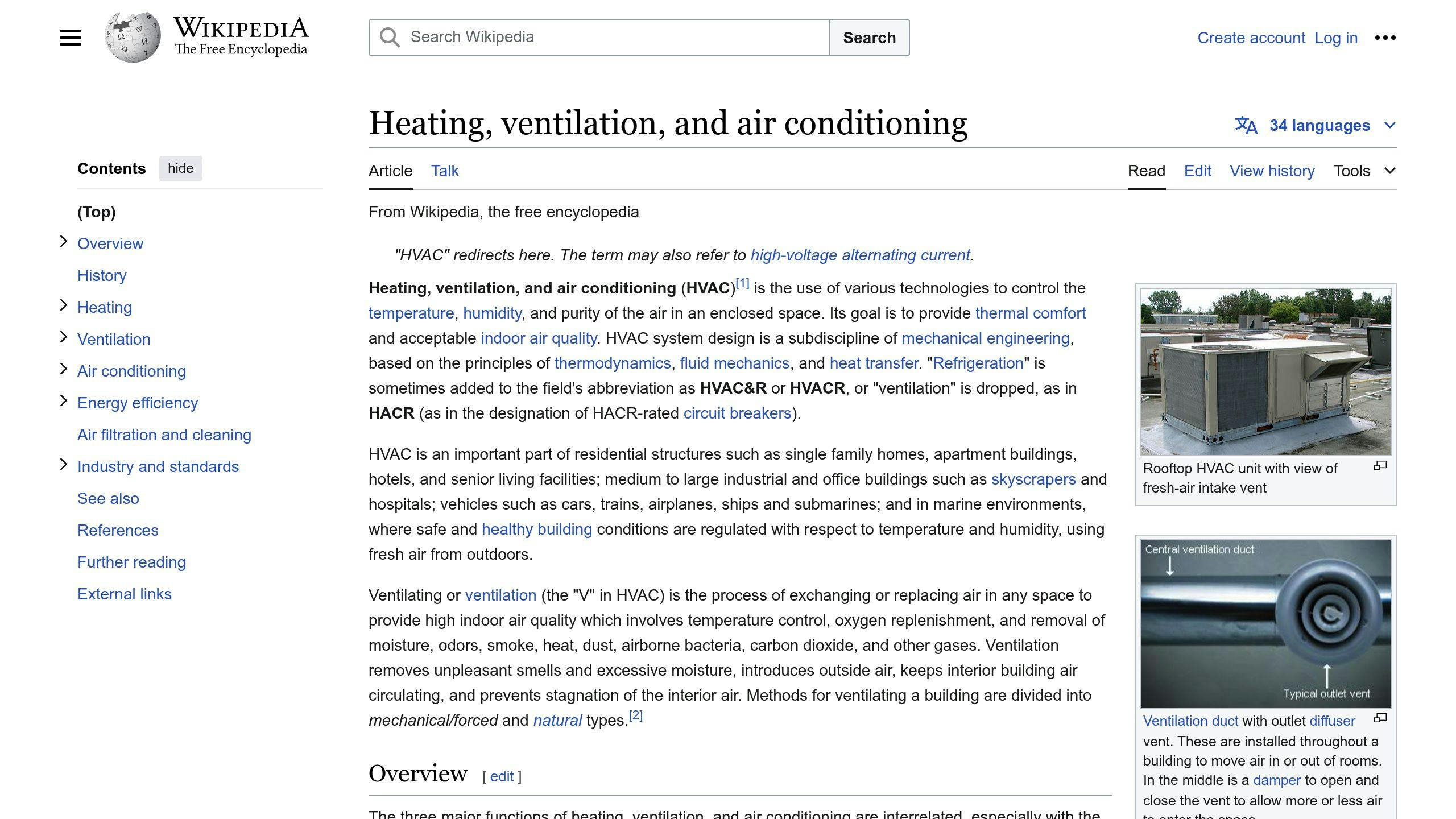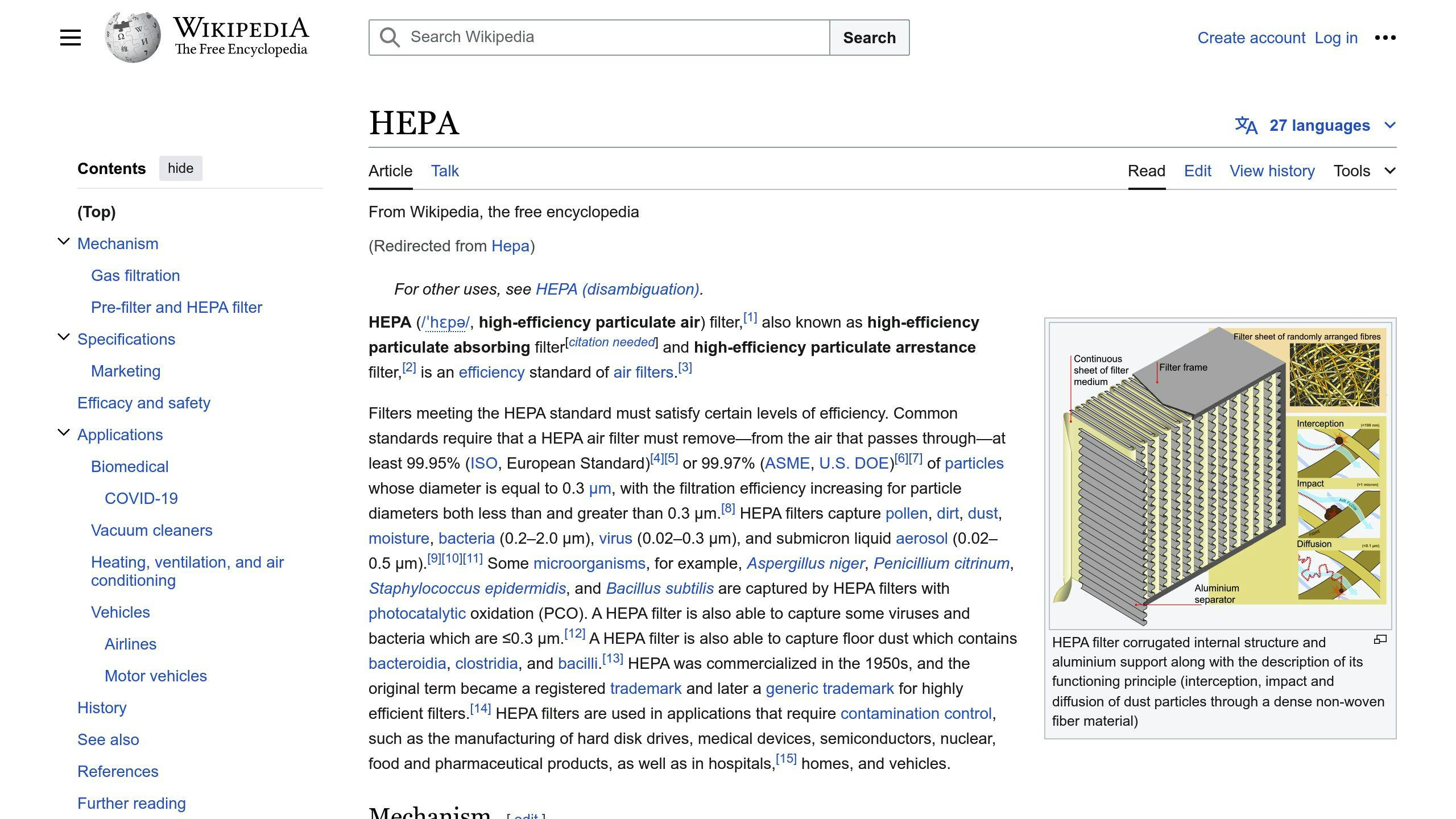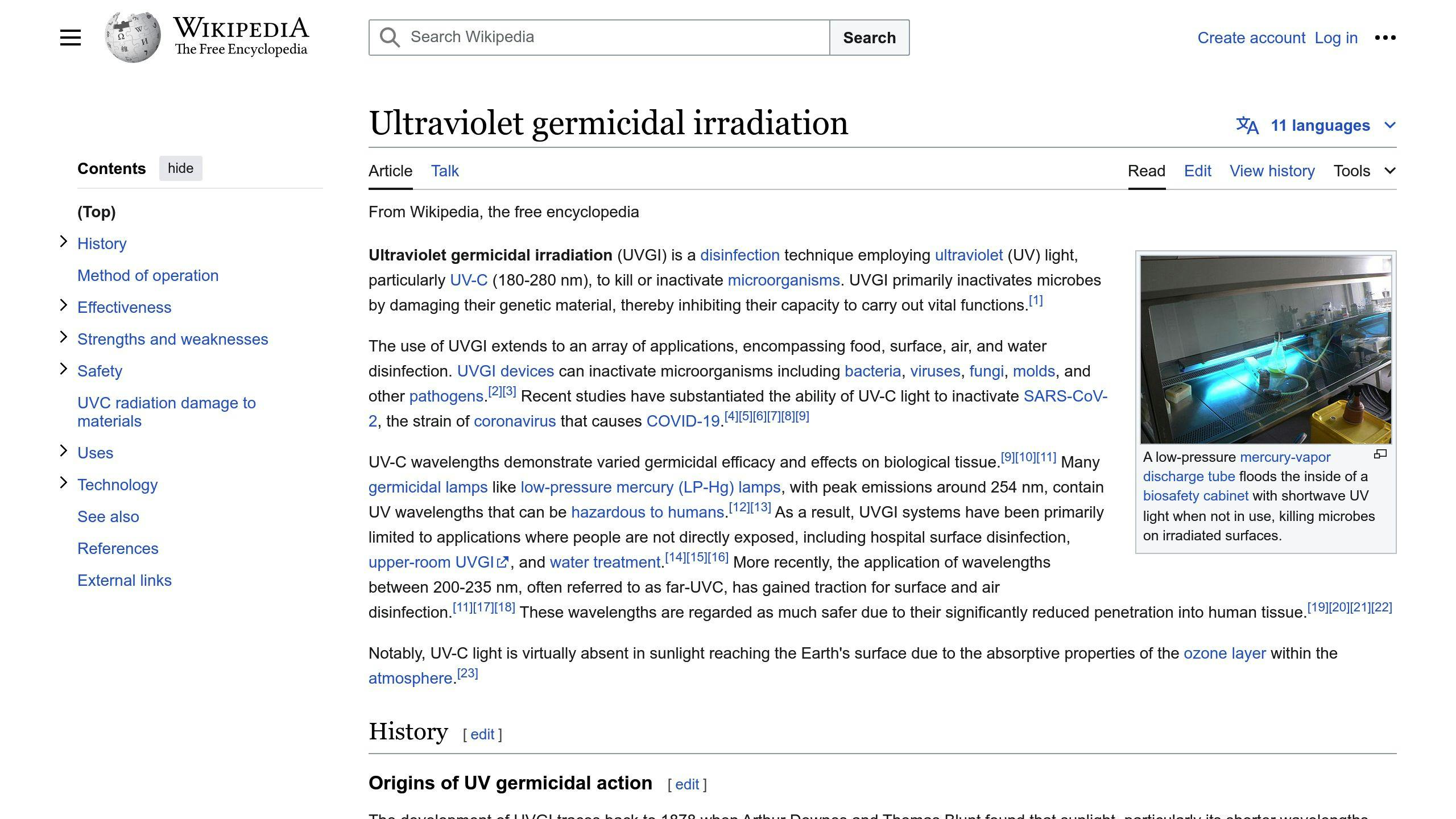Looking for the best air quality solutions for your movie theater? We've got you covered with our top 5 picks:
- HVAC Upgrades
- HEPA Filtration Systems
- UVGI (Ultraviolet Germicidal Irradiation)
- Bipolar Ionization
- Natural Air Flow Improvements
We compare each solution based on:
- How well it works at removing pollutants, controlling humidity, and preventing mold and bacteria growth
- Cost, including installation, maintenance, and energy expenses
- Ease of installation and maintenance
Related video from YouTube
Quick Comparison
| Solution | How Well It Works | Cost | Easy to Install |
|---|---|---|---|
| HVAC Upgrades | Very Good | High | Moderate |
| HEPA Filtration Systems | Very Good | Moderate | Moderate |
| UVGI | Very Good | High | Moderate |
| Bipolar Ionization | Good | Moderate | Easy |
| Natural Air Flow Improvements | Okay to Good | Low | Easy |
We dive into the details of each solution, providing you with the information you need to choose the best option for your theater's specific needs and budget. Improve the moviegoing experience and protect the health of your customers and staff by investing in the right air quality solution today.
Comparing Air Quality Solutions
To find the best air quality solution for movie theaters, we will look at three main things:
-
How Well It Works: The main goal is to improve the air quality inside the theater. We will check how well each solution removes pollutants, allergens, and other particles from the air. We will also look at how well it controls humidity and prevents mold and bacteria growth.
-
Cost: Setting up and running an air quality system can be expensive for movie theaters. We will consider the initial installation costs as well as ongoing costs like energy use, filter replacements, and maintenance fees. The ideal solution should work well without costing too much.
-
Easy to Install and Maintain: Some air quality systems are more complicated to set up and maintain than others. We will look at how easily each system can be added to existing theater buildings and how much expertise is needed to install and maintain it properly. Solutions that are user-friendly and require little maintenance will be preferred.
By evaluating each air quality solution based on these three factors, we can provide a clear comparison to help movie theater owners and managers choose the best option for their needs and budget.
| Factor | Importance | Description |
|---|---|---|
| How Well It Works | High | Ability to filter out pollutants, control humidity, and prevent mold and bacteria growth |
| Cost | Medium | Initial installation costs and ongoing costs like energy use, filter replacements, and maintenance fees |
| Easy to Install and Maintain | Medium | How easily it can be added to existing buildings, and how much expertise is needed for proper installation and upkeep |
By carefully considering each air quality solution against these factors, we can give movie theater owners and managers the information they need to select the most suitable option for their specific requirements and budget.
1. HVAC Upgrades

Upgrading the heating, ventilation, and air conditioning (HVAC) system is a popular way to improve air quality in movie theaters. This section looks at how well HVAC upgrades work, how much they cost, and how easy they are to install.
How Well It Works
- New HVAC systems have better air filters that remove pollutants, allergens, and other particles from the air
- They control humidity levels better, preventing mold and bacteria growth
- Improved ventilation brings in fresh air, reducing stuffiness and odors
Cost
- Installing a new HVAC system can be expensive, especially for larger theaters
- Energy-efficient systems can lower long-term operating costs
- Regular maintenance and filter replacements are necessary
| Cost Factor | Estimated Range |
|---|---|
| Installation | $10,000 - $50,000+ |
| Energy Savings | 10% - 30% |
| Maintenance | $500 - $2,000 per year |
Easy to Install
- Inspect the current HVAC system and plan the upgrades needed
- Hire qualified technicians to design and install the new system
- Schedule installation during off-hours to avoid disrupting movie showings
- Train staff on using and maintaining the new system properly
While upgrading the HVAC system requires a significant upfront cost and planning, it offers a comprehensive solution for improving air quality in movie theaters. The long-term benefits of better air quality and lower energy costs make it a worthwhile investment for cinema owners and managers.
2. HEPA Filtration Systems

HEPA filtration systems are a great way to improve air quality in movie theaters. This section looks at how well they work, how much they cost, and how easy they are to set up.
How Well They Work
- HEPA filters catch 99.97% of tiny particles 0.3 microns or larger, like dust, pollen, and bacteria
- They remove allergens and pollutants from the air, making it healthier to breathe
- You can combine HEPA filters with carbon filters to get rid of odors and other gases
| Particle Size (microns) | HEPA Filter Efficiency |
|---|---|
| 0.3 | 99.97% |
| 0.5 | 99.99% |
| 1.0 | 99.999% |
Cost
- Installing HEPA filters costs between $5,000 and $20,000, depending on the theater size and existing air system
- You need to replace the HEPA filters every 6-12 months, costing $500 to $1,500 per year
- Running the HEPA filters may increase energy costs by 5% to 15%
| Cost Factor | Estimated Range |
|---|---|
| Installation | $5,000 - $20,000 |
| Filter Replacement | $500 - $1,500 per year |
| Energy Increase | 5% - 15% |
Easy to Install
- Check your current air system and decide where to put the HEPA filters
- Hire a professional to design and install the HEPA filtration system
- Make sure the HEPA filters are sealed properly and have good airflow
- Train staff on replacing filters and maintaining the system
While HEPA filters require some upfront costs and regular maintenance, they are very effective at cleaning the air in movie theaters. Removing tiny particles and allergens can make the theater experience much better and healthier for customers and employees.
3. UVGI (Ultraviolet Germicidal Irradiation)

UVGI (Ultraviolet Germicidal Irradiation) is a way to clean the air using UV-C light. This section looks at how well UVGI works to kill germs in the air, how much it costs, and how easy it is to set up in movie theaters.
How Well It Works
- UVGI systems can kill 99.9% of viruses, bacteria, and other germs in the air
- UV-C light damages the DNA of these germs, stopping them from spreading
- UVGI works best when combined with other air cleaning methods like HEPA filters
| Germ Type | UVGI Killing Rate |
|---|---|
| Viruses | 99.9% - 99.99% |
| Bacteria | 99.9% - 99.999% |
| Mold | 99.9% - 99.99% |
Cost
- Installing UVGI can cost between $10,000 and $30,000, depending on the theater size and air system
- Yearly maintenance costs range from $1,000 to $3,000, including replacing UV lamps every 9-12 months
- Energy costs may go up by 10% to 20% due to the power needed for UV lamps
| Cost Factor | Estimated Range |
|---|---|
| Installation | $10,000 - $30,000 |
| Maintenance | $1,000 - $3,000 per year |
| Energy Increase | 10% - 20% |
Easy to Install
- Check your current air system and find good spots for UVGI units
- Hire a certified UVGI expert to design and install the system
- Put safety measures in place to prevent UV exposure to staff and customers
- Train maintenance staff on how to handle and replace UV lamps safely
While UVGI systems cost more upfront compared to some other air cleaning options, their ability to kill germs in the air makes them a good investment for movie theaters. By adding UVGI to existing air systems, theaters can provide a safer and healthier environment for customers and employees.
sbb-itb-b1b0647
4. Bipolar Ionization
Bipolar ionization is a way to clean the air in movie theaters. This section looks at how well it works, how much it costs, and how easy it is to set up.
How Well It Works
- Bipolar ionization creates positive and negative ions that attach to and neutralize particles, bacteria, and viruses in the air
- These ions can reduce small particles (PM), gases (VOCs), and odors in the air
- How well it works depends on things like the number of ions, airflow, and the type of pollutant
| Pollutant | Reduction Rate |
|---|---|
| Small Particles (PM2.5) | 30% - 95% |
| Bacteria | 90% - 99.9% |
| Viruses | 85% - 99% |
| Gases (VOCs) | 50% - 90% |
Cost
- Installing bipolar ionization costs between $0.50 and $3.00 per square foot, depending on the system and theater size
- Yearly maintenance is usually 10% to 20% of the installation cost
- It uses a little more energy, with a 1% to 5% increase in HVAC energy use
| Theater Size (sq. ft.) | Installation Cost | Annual Maintenance |
|---|---|---|
| 10,000 | $5,000 - $30,000 | $500 - $6,000 |
| 25,000 | $12,500 - $75,000 | $1,250 - $15,000 |
| 50,000 | $25,000 - $150,000 | $2,500 - $30,000 |
Easy to Install
- Check your current HVAC system and find good spots for the bipolar ionization devices
- Choose a bipolar ionization system that fits your theater size, layout, and air quality needs
- Hire a professional HVAC contractor to install the devices in the air handling units or ductwork
- Make sure the devices are wired properly and connected to the HVAC control system
- Train maintenance staff on how to monitor and maintain the bipolar ionization system
Compared to other air cleaning options, bipolar ionization is fairly easy to install in existing HVAC systems without major changes. The small devices can be fitted into air handling units or ducts, causing little disruption during installation.
While the upfront costs may be higher than some options, bipolar ionization's ability to neutralize many types of air pollutants and low maintenance needs make it a good choice for movie theaters wanting to improve indoor air quality.
5. Natural Air Flow Improvements
Natural air flow improvements are a simple and eco-friendly way to enhance air quality in movie theaters. By optimizing air circulation, these systems can reduce pollutants and provide a healthier environment for moviegoers. While not as powerful as some other options, natural air flow improvements are relatively easy to install and maintain, making them a budget-friendly choice for theaters looking to improve air quality.
How It Works
- Improves air movement and reduces stale air pockets
- Dilutes and removes pollutants, allergens, and odors
- Works best in mild climates and when combined with other air cleaning methods
| Ventilation Method | Pollutant Reduction |
|---|---|
| Cross Ventilation | 30% - 60% |
| Stack Ventilation | 20% - 50% |
| Night Flushing | 40% - 80% |
Cost
- Installation costs range from $2,000 to $10,000, depending on the theater size and existing ventilation system
- Low maintenance costs, mainly cleaning and adjusting vents and openings
- Can reduce energy costs by 10% to 30% compared to mechanical ventilation
| Theater Size (sq. ft.) | Installation Cost |
|---|---|
| 10,000 | $2,000 - $5,000 |
| 25,000 | $5,000 - $8,000 |
| 50,000 | $8,000 - $10,000 |
Easy Setup
- Assess the theater's current ventilation system and identify areas for improvement
- Design a natural ventilation plan that optimizes air flow and circulation
- Install or modify vents, windows, and openings to enable effective natural ventilation
- Test and adjust the system to ensure proper functioning and air quality improvement
- Train staff on maintaining and operating the natural ventilation system
Natural air flow improvements are one of the easiest air quality solutions to implement in movie theaters. By leveraging existing openings and making minor modifications, theaters can significantly improve air circulation and reduce pollutants without major renovations or disruptions.
While natural ventilation may not be as effective as some mechanical or filtration systems, its low cost, eco-friendliness, and ease of installation make it a viable option for theaters looking to enhance air quality and provide a more comfortable environment for their patrons.
Comparing Solutions
Choosing the right air quality solution for your movie theater is important. Here's a simple comparison of the top 5 options based on how well they work, their cost, and how easy they are to install.
| Solution | How Well It Works | Cost | Easy to Install |
|---|---|---|---|
| HVAC Upgrades | Very Good | High | Moderate |
| HEPA Filtration Systems | Very Good | Moderate | Moderate |
| UVGI | Very Good | High | Moderate |
| Bipolar Ionization | Good | Moderate | Easy |
| Natural Air Flow Improvements | Okay to Good | Low | Easy |
HVAC Upgrades vs. HEPA Filtration Systems
- Both are great at removing pollutants and allergens from the air
- HVAC upgrades control humidity and ventilation better
- HEPA filters are cheaper and simpler to install
UVGI vs. Bipolar Ionization
- UVGI is better at killing germs and viruses
- Bipolar ionization is better at neutralizing particles and odors
- Bipolar ionization is easier to install and maintain
Natural Air Flow Improvements
- The most affordable and eco-friendly option
- Works well for mild climates and smaller theaters
- Best when combined with other air cleaning methods
When choosing an air quality solution, consider your theater's:
- Size: Larger theaters may need more powerful systems like HVAC upgrades or UVGI
- Budget: If cost is an issue, HEPA filters or natural air flow improvements may be better
- Climate: In mild climates, natural ventilation can be effective and energy-efficient
- Existing Infrastructure: Some solutions, like bipolar ionization, are easier to add to existing HVAC systems
Evaluate your theater's needs and compare the options. Investing in good air quality protects the health of your customers and staff, and improves the overall moviegoing experience.
Final Thoughts
Picking the right air quality solution for your movie theater is important. It helps create a better experience for viewers and aligns with Filmgrail's goal of providing excellent cinema experiences. By looking at how well each option works, the cost, and how easy it is to install, theater owners and managers can choose the best fit for their needs.
| Solution | Key Benefits | Main Things to Consider |
|---|---|---|
| HVAC Upgrades | Improves overall air quality, controls humidity | High upfront cost, moderately difficult to install |
| HEPA Filtration Systems | Very effective at removing pollutants and allergens | Moderate cost, filters need regular replacement |
| UVGI | Excellent at killing germs and viruses | High cost, moderately difficult to install |
| Bipolar Ionization | Good at neutralizing particles and odors, easy to install | Moderate cost, effectiveness varies based on conditions |
| Natural Air Flow Improvements | Low cost, eco-friendly, easy to implement | Effectiveness depends on climate and theater layout |
When choosing an air quality solution, theater owners should prioritize:
-
Effectiveness: Pick a solution that addresses the specific air quality issues in your theater, such as pollutants, allergens, or germs.
-
Budget: Consider both the upfront installation costs and ongoing maintenance expenses to ensure it fits your theater's budget.
-
Ease of Installation: Choose a solution that can be easily added to your existing setup without causing major disruptions.
-
Theater-Specific Needs: Evaluate your theater's unique requirements, such as size, climate, and customer preferences, to select the best solution.
By investing in the right air quality solution, movie theaters show their commitment to providing a safe, comfortable, and enjoyable experience for their patrons. This aligns with Filmgrail's mission of helping cinemas grow their brand, increase ticket sales, and improve the moviegoer experience.
As the cinema industry evolves, prioritizing air quality will become more important in attracting and keeping customers. By staying informed about the latest air quality solutions and making smart investments, movie theaters can position themselves for long-term success and maintain a competitive edge in the market.
FAQs
Do movie theaters have air purifiers?
Yes, most modern movie theaters have air purification systems built into their HVAC (heating, ventilation, and air conditioning) units. These systems typically include:
- Fresh air vents in the ceiling
- Air filters to remove pollutants
- Constant air circulation and refreshment
This helps keep the air quality high in each auditorium, providing a comfortable and healthy environment for moviegoers.
What sound system do movie theaters use?
Many movie theaters use advanced sound systems like Dolby Atmos to provide an immersive audio experience. Dolby Atmos features:
- Overhead speakers for 3D sound
- Precise placement of audio elements
- Compatibility with various theater configurations
This system allows filmmakers to create more realistic and engaging soundscapes, enhancing the overall movie-watching experience.
Is there a device that cleans the air?
Yes, there are several devices designed to clean the air in various settings, including homes and businesses. One popular example is the GermGuardian HEPA Air Purifier, which offers:
- HEPA filters to remove 99.97% of pollutants
- UV-C light technology to kill germs and bacteria
- Large room coverage for effective air cleaning
Air purifiers like this can help reduce exposure to harmful particles, allergens, and other airborne contaminants.
Do air filtration systems really work?
Air filtration systems can be effective in reducing exposure to harmful pollutants, which may have long-term health benefits. While they may not directly or immediately improve a person's health, studies suggest that air purifiers can:
- Remove airborne particles, allergens, and pollutants
- Improve indoor air quality
- Reduce the risk of respiratory issues
The effectiveness of an air filtration system depends on factors such as the type of filter used, the size of the space, and the level of maintenance.
Are air filtration systems expensive?
The cost of air filtration systems can vary widely depending on the type, size, and features of the unit. On average, the national cost for a whole-house air filtration system ranges from $435 to $4,960, with an average price of $2,631.
| System Type | Price Range |
|---|---|
| Budget units | Below $100 |
| Average systems | $435 - $4,960 |
| High-end units | Up to $10,000 |
Some factors that can affect the cost of an air filtration system include:
- Size of the space to be covered
- Type of filter (HEPA, carbon, etc.)
- Additional features (UV-C light, smart controls)
- Installation requirements
While some high-end, hospital-grade purification units can be expensive, there are also more affordable options available for homes and businesses looking to improve their indoor air quality.


